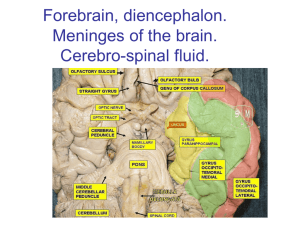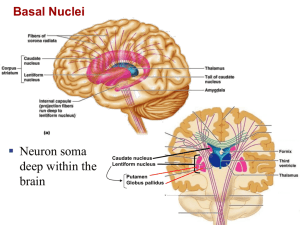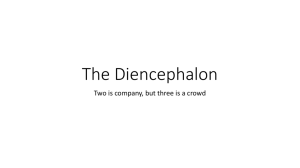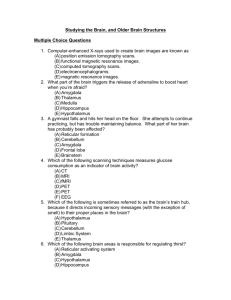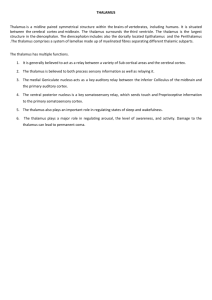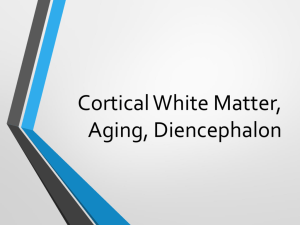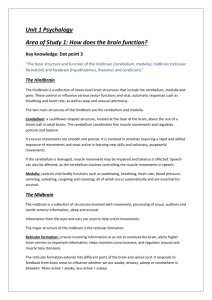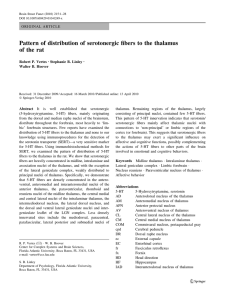neurology_lec7_21_3_2011
advertisement
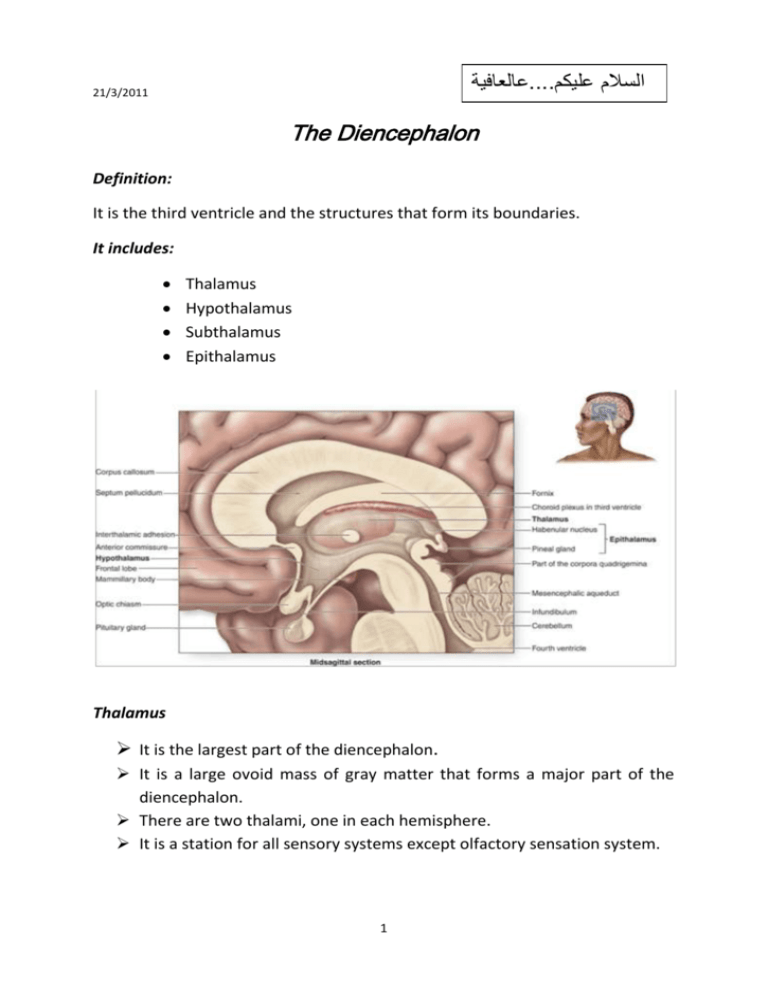
عالعافية....السالم عليكم 21/3/2011 The Diencephalon Definition: It is the third ventricle and the structures that form its boundaries. It includes: Thalamus Hypothalamus Subthalamus Epithalamus Thalamus It is the largest part of the diencephalon. It is a large ovoid mass of gray matter that forms a major part of the diencephalon. There are two thalami, one in each hemisphere. It is a station for all sensory systems except olfactory sensation system. 1 Boundaries of the thalamus The anterior border of the thalamus is surrounded by part of the lateral ventricle and interventricular foramen, (the anterior end of the thalamus forms the posterior boundary of interventricular foramen). The posterior border is formed by the pulvinar which is the largest nucleus inside the thalamus. The superior border is formed by the fornix and choroid plexus. The inferior border is formed by the midbrain. The thalamus is surrounded medially by the third ventricle from both sides and the interventricular adhesion (which is a commissural tract that connects the two thalami together). The lateral boundary of the thalamus is formed by the internal capsule and lateral to the internal capsule lies a nucleus in the white matter known as lentiform nucleus which is a part of the basal nuclei (basal ganglion). Notes: The internal capsule is an example of a projection fiber. The name “basal ganglion” is a wrong nomenclature because it is located inside the central nervous system so it should be called “basal nuclei”. 2 The thalamus is subdivided into anterior, medial and lateral parts by the internal medullary lamina, and in each part we have a group of thalamic nuclei. Each nucleus is named according to its location and each has its own function. Note: The internal medullary lamina is a Y shaped part of white matter. Functions of thalamus: Relaying sensations, spatial sense and motor signals to the cerebral cortex, along with the regulation of consciousness, sleep and alertness. Sensory function: It relays all sensory information from the spinal cord to the S1 area inside the cortex. Motor function: The basal ganglia, cerebral cortex and the cerebellum are responsible for motor functions. The thalamus also has a role in motor functions through its nuclei which are connected to the basal ganglia. Subthalamus The subthalamus is located inferior to the thalamus, and its structure is extremely complex because many sensory tracts pass through it. It has subthalamic nuclei that have connections with corpus striatum. Generally, the subthalamus influences motor functions. Epithalamus The epithalamus consists of habenular nucleus and pineal gland. The right and left habenular nuclei are connected together by the habenular commissure. The function of the habenular nucleus is the integration between all sensations including olfactory and visceral sensations. 3 The pineal gland is a conical shaped endocrine gland, connected to the diencephalon by a stalk. This stalk is bounded superiorly by the habenular commissure and inferiorly by the posterior commissure. The pineal gland inhibits all endocrine glands either directly through CSF or indirectly through the blood stream. Note: We have two thalami, one hypothalamus, two habenular nuclei and one pineal gland. Hypothalamus The hypothalamus extends from optic chiasm and ends posteriorly at mammilary bodies. It lies below the hypothalamic sulcus on the lateral wall of the third ventricle. The hypothalamic sulcus separates the thalamus from the hypothalamus. Functions of Hypothalamus There is hardly any activity in the body that is not influenced by the hypothalamus. It has an effect on temperature e.g. it affects mechanisms that dissipate or collect heat through sweating and dilatation of blood vessels underneath the skin. Emotional regulation. Sexual behaviour. It affects the emotional and sexual behaviours through its connection to the prefrontal cortex. Hunger and thirst. 4 Neurosecretion. Endocrine control The hypothalamus is subdivided into medial and lateral parts. The lateral part consists of nuclei responsible for hunger (hunger centre) and thirst (thirst centre). A bilateral destruction to the hunger centre causes anorexia which is a loss of appetite. Stimulation of the thirst centre causes the person to drink more water. The medial part of the hypothalamus contains the satiety centre ()شبع. A destruction to the satiety centre results in obesity. The hypothalamus, in addition to its effects on other glands (either stimulating or inhibiting them to release their hormones), it secretes its own hormones (cytosine and vasopressin). "Whoever follows patience, success will follow him” Dedicated to: Farah Tsey (pure Cherkess) Shellet elle ma elo shelleh: Fatimah Abu Sheikha ()طول عمري بريدا Meissa Nl (half Greek half Qalqeeli) Nadia Nayef (half Ukrani half 5aleeli) DZana Hamdan (Italiano) Maram Bassam (Wikipedia in your smiley ) Layan Assardi ()المفرق Saja elnsour ()على طريق السلط Layal Awwad ()أشعلت قلمي و تركتني بكلماتي أحترق AlBatoul ()انزل عالساحة يا منتخبنا Malak Allan (miss you) Nour Kasabi ()المقعد الشركسي Rand Herz +Safa Dalahmeh+ Fayza =]] Hadeel Msameh+ Farah Omari ()الشماالت Hadeel Tarek +Arwa almousa =]] Best wishes Isra M. Abu Ghoush 5
